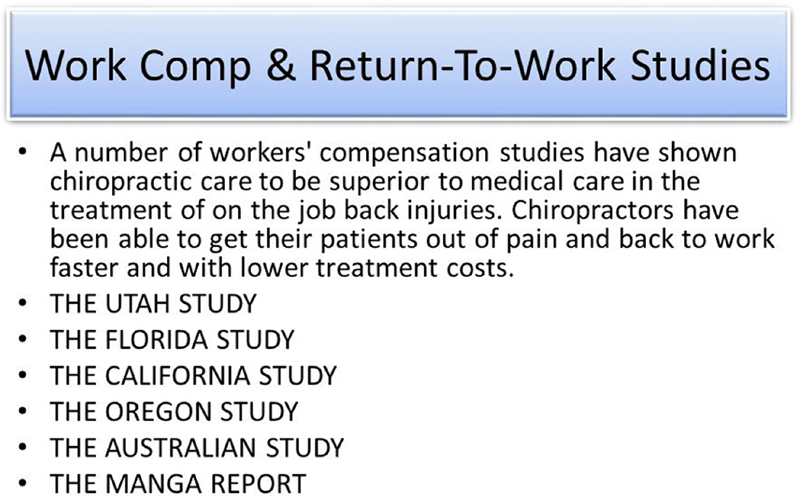Patients’ Experiences With Vehicle Collision to Inform the Development of Clinical Practice Guidelines: A Narrative Inquiry
SOURCE: J Manipulative Physiol Ther 2016 (Feb 26) [EPub]
Gail M. Lindsay, RN, PhD, Silvano A. Mior, DC, PhD,
Pierre Côté, DC, PhD, Linda J. Carroll, PhD,
Heather M. Shearer, DC, MSc
Associate Professor,
Faculty of Health Sciences,
University of Ontario Institute of Technology,
Oshawa, ON
OBJECTIVE: The purpose of this narrative inquiry was to explore the experiences of persons who were injured in traffic collisions and seek their recommendations for the development of clinical practice guideline (CPG) for the management of minor traffic injuries.
METHODS: Patients receiving care for traffic injuries were recruited from 4 clinics in Ontario, Canada resulting in 11 adult participants (5 men, 6 women). Eight were injured while driving cars, 1 was injured on a motorcycle, 2 were pedestrians, and none caused the collision. Using narrative inquiry methodology, initial interviews were audiotaped, and follow-up interviews were held within 2 weeks to extend the story of experience created from the first interview. Narrative plotlines across the 11 stories were identified, and a composite story inclusive of all recommendations was developed by the authors. The research findings and composite narrative were used to inform the CPG Expert Panel in the development of new CPGs.
RESULTS: Four recommended directions were identified from the narrative inquiry process and applied. First, terminology that caused stigma was a concern. This resulted in modified language (“injured persons”) being adopted by the Expert Panel, and a new nomenclature categorizing layers of injury was identified. Second, participants valued being engaged as partners with health care practitioners. This resulted in inclusion of shared decision-making as a foundational recommendation connecting CPGs and care planning. Third, emotional distress was recognized as a factor in recovery. Therefore, the importance of early detection and the ongoing evaluation of risk factors for delayed recovery were included in all CPGs. Fourth, participants shared that they were unfamiliar with the health care system and insurance industry before their accident. Thus, repeatedly orienting injured persons to the system was advised.
There are more articles like this @ our:
CONCLUSION: A narrative inquiry of 11 patients’ experiences with traffic collision and their recommendations for clinical guidelines informed the Ontario Protocol for Traffic Injury Management Collaboration in the development of new Minor Injury Guidelines. The values and findings of the qualitative inquiry were interwoven into each clinical pathway and embedded within the final guideline report submitted to government.
Copyright © 2015 National University of Health Sciences. Published by Elsevier Inc. All rights reserved.
KEYWORDS: Accidents, Traffic; Neck Pain; Outcome and Process Assessment (Health Care), Personal Narratives as Topic; Qualitative Research; Whiplash Injuries
From the FULL TEXT Article:
Introduction
Whiplash and neck pain and associated disorders affect more than 80% of individuals with minor injuries after a motor vehicle collision. [1] Many who are injured seek treatment by attempting to navigate the management corridor lined with various health care, insurance, legal, and regulatory systems. In Ontario, Canada, the government regulates the management of treatment for injuries following traffic collisions. [2] Currently, such injuries are classified as “minor,” “noncatastrophic,” or “catastrophic.” In 2011, the Ontario government called for the development of a new evidence-based clinical practice guideline (CPG) for the management of minor traffic injuries.
The Ontario Protocol for Traffic Injury Management (OPTIMa) Collaboration [3] was established to develop the new Minor Injury Guidelines (MIGs). The OPTIMa Collaboration included a multidisciplinary guideline expert panel of clinicians, academics and scientists, a consumer advocate, a retired judge, automobile insurance industry experts, and a patient liaison. Well-accepted standardized wording and criteria were used by the OPTIMa Collaboration for conducting research and developing clinical guidelines for people injured in traffic collisions. Systematic reviews and the translation of the scientific evidence into evidence-based recommendations were augmented by a qualitative inquiry which includes patient perspectives as per guideline development standards. [4-9]
SOURCE: Read the rest of this Full Text article now!




Leave A Comment